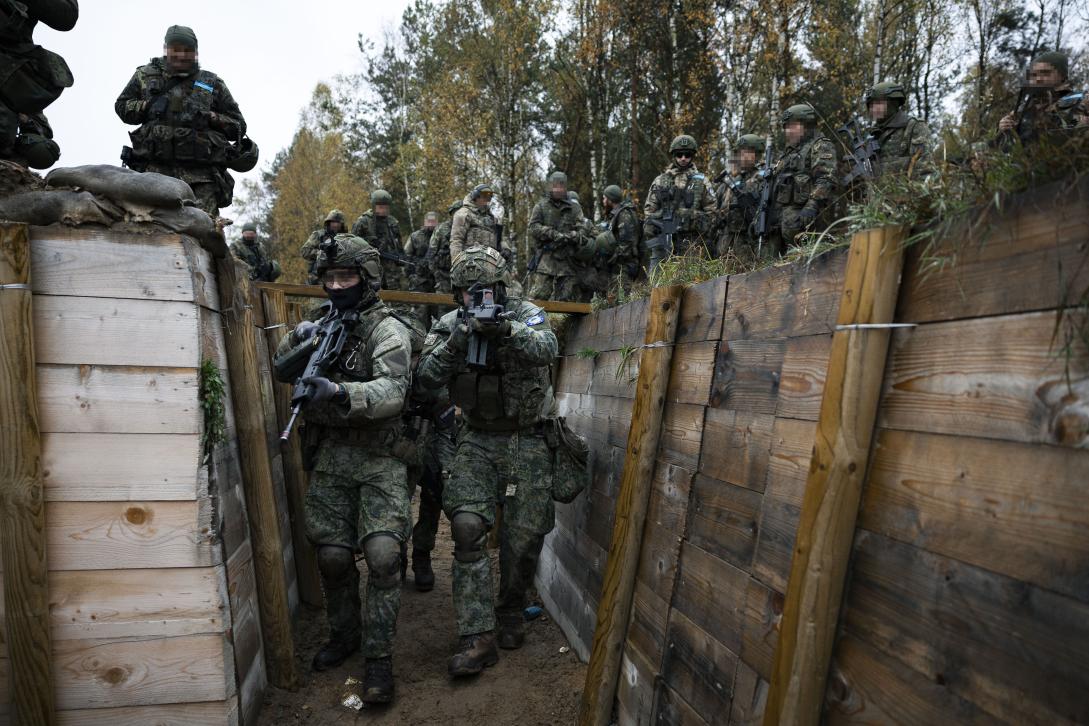Preparing Ukrainians for battle

The Assault Section Sapper Course, part of the European Union Military Assistance Mission Ukraine (EUMAM UA), takes place under the banner of the European Union. It is open to all Ukrainians, professional and conscript soldiers. Some 65,000 Ukrainians have been trained since its launch eighteen months ago. By the end of winter, EUMAM UA hopes to have prepared around 75,000 men and women. In recent weeks, 76 went through a realistic training.
Tools and insights
The course included lessons such as self-help and comradeship, weapons knowledge, humanitarian law of war, handling mines and metal detectors. But also: how to fight in an urban area, the forest, on the moors and in trenches. However, the Assault Section Sapper Course is not a full-fledged training course. ‘We ‘merely’ provide trainees with tools and insights. After all, you cannot fully train a soldier in four weeks,’ explains training support officer First Lieutenant Vincent of 11 Armoured Engineer Battalion.
Instructors from Germany, the Netherlands, Lithuania, and Slovenia lead the training programme. Assisted by interpreters. ‘The Ukrainians understand English to some extent, but hardly speak it,’ knows Vincent, who emphasises once again: the Assault Section Sapper Course is not just an exercise, but training for concrete-hard reality. After all, the trainees are entering a war. ‘As has happened with previous participants, some may die in the coming months. But for now, it feels nice to be able to do something ‘real’ for them.’
Better communication
As Vincent watches them, the Ukrainians go full steam ahead in an exercise in ‘capturing’ a building. In it, according to the exercise scenario, Russians are hiding. According to the lieutenant, Ukrainian morale is fine. ‘They like fighting for their country, although some also say, ‘if I break a leg in this course at least I don't have to go to war’.’
During an evaluation, a Belgian instructor expresses satisfaction through an interpreter. However, mutual communication could be better, he stresses. Another instructor agrees. ‘The more training, the better it goes.’
Much more ‘kinetic’
Even during training in trenches, Ukrainians go for it. Shuffling from left to right, they make their way, looking around vigilantly. Where is the enemy? ‘Questions?’ asks instructor Sergeant-Major Wessel in a pause. ‘Na,’ sounds in Ukrainian. ‘They pick up the learning well. After every training session, many Ukrainians give me a ‘high-five’. Yes, this work gives satisfaction, although things are much more kinetic (mobile, ed.) at the front than here. When you hear what kind of weapons the Russians use... You can't imitate them here. I try not to think about what could happen to these men over there.’
One of the Ukrainians is 47-year-old Korneliu. He enlisted voluntarily to, as he puts it, ‘fight the enemy’. In the EUMAM course, he learned a lot about drones, booby traps and tripwire systems. However, he finds it a touch on the short side which means he does not have too much time to learn everything in detail. ‘We get a lot of information and therefore just need more time to learn everything properly. But as I said, I am definitely picking up a lot.’ Although volunteered, Korneliu feels fear of going to the front. ‘On the other hand: fear is a man's enemy and fighting is my profession.’
Hugely motivated
Similar feelings also live on in Iwan, who donned the military suit to ‘stop the aggressor’. He feels happy in the Assault Section Sapper Course. ‘In Ukraine, it will be difficult to destroy the enemy, but we are hugely motivated to do so,’ he says.
Impressive moment
Every day before the start of the programme, the war in Ukraine made itself felt at the training site, somewhere in eastern Germany. Between 08:00 and 08:01, the fallen Ukrainians were remembered in a ceremony. An equally sad but at the same time impressive moment.









